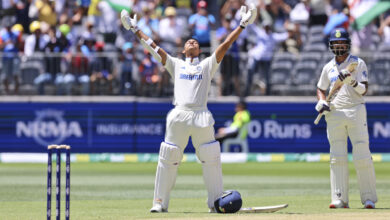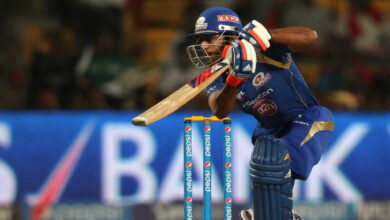How a Japanese Manga and Anime ‘Blue Lock’ and ‘Captain Tsubasa’ mirror Japan’s great win over Germany at the World Cup

Even as Takumi Asano crunched himself into a corner with barely any space visible between the champion German goalkeeper Manuel Neuer and the goalpost, especially with the six-feet-two inches tall Nico Schlotterbec about to shoulder-barge him again, he would conjure a dreamy right-footer that would blast the ball past the startled Neuer. Asano doesn’t bail out of the moment, trying to pass the ball behind in hope that the in-rushing team-mate would get to it – – he just blasts it. Just like the strikers in the Manga Blue Lock.
Japanese fans, devoted as they are to their football Manga (Manga is Japanese comic and graphic books) from the epic Captain Tsubasa to the current sensation Blue Lock, saw the anime’s imprint on real life.
“A striker who chokes in front of the goal simply doesn’t have what it takes to be one,” says a Blue Lock character Shoei Baro. Takumi Asano would agree.
The Blue Lock Manga has been screaming for this day. The Manga created Yusuke Nomura’s plot runs thus: After Japan blew a lead to lose to Belgium, it’s believed that what they need is some ego in their strikers who are hungry for goals and don’t fuss too much about the old Japanese ideals of teamwork so much that they miss the moment to shoot. A new coach is hired who trains talented young footballers in a prison-like facility called Blue Lock.
Not long after Asano thundered in the goal to down Germany at Qatar, the Blue Lock Manga’s Twitter handle put up a post: “Awesome! Ego!”
Blue Lock and Adidas collab with Japan national team equipment pic.twitter.com/8C9kMWkd6K
— Shonen Magazine News (@WSM_manga) August 29, 2022
Blue Lock has a closer relationship with Japan’s football team. In August this year, the Japanese football team revealed their jerseys for the Qatar world cup, incorporating Origami elements, the Japanese art of folding paper, as a symbol of praying for happiness. The jersey reveal was done in collaboration with football manga Blue Lock and Giant Killing. The characters were sporting the new jersey in the launch, done with the cooperation of the illustrators of the manga Yusuke Nomura and Tsujitomo.
There is a famous quote from the Blue Lock’s coach Jinpachi Ego: “My job is to make Japan a team capable of winning the World Cup.I’ll put it in simple terms. Japan only requires one thing to become the strongest powerhouse in football. And that is the creation of the revolutionary striker. From you 300 players gathered here today, I will forge the best striker in the world through a certain project. All of them revolutionary strikers!! Their extraordinary egoism is the one thing Japan’s football lacks. You will not become the greatest strikers in the world, unless you have the ego to match. My purpose here is to create such a player in Japan.”
****Japanese Manga isn’t just restricted to sports or kids’ comics – it’s consumed adults and has topics that vary from political, erotic, cultural, soap-opera-ish storylines, science fiction, poetry, horical – the whole jazz basically. But it’s the football mangas that have crazy fan following from the epic Captain Tsubasa that has a worldwide fandom to the Blue Lock which is currently airing in Japan.
It’s generally seen as a post-second-world-war phenomenon, but Tokyo professor Brigitte Koyama-Richard has dated it back to scroll-paintings in the 12th century in her book ‘One thousand years of Manga’. Scholarly studies on Manga, and graduate school programs are in place now in Japan. But the football mangas are the real craze.
We end this weeks #NewMangaDay with Japan favorite soccer stars:
⚽Blue Lock, Volume 12⚽ Muneyuki Kaneshiro and Yusuke Nomura
👟The Japan Football Union is hell-bent on creating a striker who hungers for goals and thirsts for victory.
Digital: https://t.co/FOEpypsUIB pic.twitter.com/Ts6NbRygTY
— Kodansha USA (@KodanshaManga) March 18, 2022
Captain Tsubasa was the first manga with a worldwide fandom. Tsubasa is a charming character created in 1981, but has transcended beyond the imagination of even its creator Yoichi Takahashi.
In ’83, it was casted as anime on television, and has been translated and broadcasted all over the world. In the middle east, kids know him as Captain Majed. In North America, he was Flash kicker. In South America his show was called Supercampeones. In Europe, the wondrous football anime star was named Oliver.
It’s in that context that in 2019, its creator Takahashi said: “Reality caught up with the manga, and then surpassed it.” He can say that again today after Japan’s epic win over Germany.
Captain Tsubasa continues to inspire the present-day footballers in Germany. In 2017 when the U-17 world cup was held in India, Japan had come for a game in Guwahati.
Not being a polyglot, one had propped up the phone with images of Captain Tsubasa loaded at Taisei Miyashiro, the 17-year Japanese forward who was playing in that tournament. Miyashiro’s face creased into this lovely little smile as he exclaimed: “Tsubasa!”
” id=”yt-wrapper-box” >
“When I was a boy I loved the character and wanted to play like him. As I grew older, I realised I can’t copy those difficult moves!” Laughter.
Fernando Torres, the Spanish great, had once said: “I started playing football because of this.” Ditto Franscesco Cocco and Alessandro Del Piero, who treasures a signed drawing from the creator Takahashi. Lukas Podolski, who plays in Japan these days, is a great fan, even playing with a boot that has a huge imprint of Tsubasa.
No surprise then that it’s the most popular in Japan. Hidetoshi Nakata, the first Japanese success in European leagues, doesn’t watch football even now. He never did as a kid. It was Tsubasa who ensnared him, and made him want to copy the moves. Players from Zinedine Zidane to Ronaldinho have talked about the influence of the character in their football development.
***Captain Tsubasa is a boy in love with football and dreams of winning the world cup for Japan. At the start of the series he was 11, and nearly four decades later the series is still going strong – Tsubasa is in his early 20’s, and plays for Japan and FC Barcelona.
The series isn’t just about him – it has the very popular goalkeeper Wakabayashi (Benji in Europe) and other characters who all have their background stories etched out in great detail. It has signature shots from Tsubasa: heel lift cyclone, razor shot, off-the-bar overhead kick, drive shoot – the l goes on and the ball goes through astonishing curves, sometimes spins differently and basically defies science. In a shot skylab hurricane, two players push their legs together to propel one into the air to head the ball for a goal. No wonder poor Miyashiro said he couldn’t even copy.
How Tsubasa inspired attacking midfielders in Japan
It has had another curious, and an astounding, effect on Japanese football. Tsubasa is an attacking midfielder, a playmaker in the mold of Diego Maradona, and for long the Japanese kept producing midfielders. Keisuke Honda (of AC Milan), Shinji Kagawa (Manchester United), Makota Hasebe (FC Nurnberg) were all midfielders in the mould of Tsubasa. And even the Japanese forwards like Hiroshi Kiyotake, Shinji Okazaki, Yoichiro Kakitani, and Takashi Inui all played as midfielders for their respective clubs and only moved into attacking positions when playing for Japan.
So much so that around 2002 when Japan hosted the world cup, a corporate company approached Takahashi to create a popular striker. And he came up with a classic Anti-Tsubasa in Kanou Kyosuke in the series Hungry Heart. Takahashi hoped it would create a legion of forwards, and going the current set of teenagers, it seems to be working. “Japan weren’t good in offense. I wanted them to have attacking strikers, and created Kyosuke,” he said then.
Now, it’s the time of the manga Blue Lock, that demands some hunger and ego in its strikers. It seems it’s working. A new generation of attackers are arriving.
Tom er, the American who revolutionised grassroots football in Japan with his football clinics and TV shows, told The Indian Express about the influence of anime.
“There is absolutely no doubt in my mind that Captain Tsubasa was central in kicking football interest in Japan. Many of the kids in my clinics, in the 80’s and ‘90s’, would talk about it. The creator Takahashi is a very nice humble man, who is pleased with what he has done and surprised how it has spread all over the world.” It even inspired er to create football comic books, which proved to be a great success. “It was in the comics called Korokoro Komikko, hundreds of pages with storylines from video games and my football strip. It was huge: a circulation of 1.2 million in the heydays.”
” id=”yt-wrapper-box” >
Which is huge but nothing in comparison to Captain Tsubasa that was serialised in the weekly ‘Shonen Jump’ and had 5 million at its pomp, and even now attracts 3 million readership.
“In France, football is played in leagues. In Japan, it’s in schools. It’s this close bond between sport and things like: links between friends, upper class and lower class, parents and all the heartful things that I wanted to capture in my manga,” Takahashi once said.
A baseball fan as a kid, Takahashi was first drawn towards football in his high school when he watched the 1978 world cup in Argentina. He was truly hooked, and three years later he rolled out the football manga Captain Tsubasa. Before him, there were at least two other football mangas – The Red-Blooded Eleven and Shinji Mizushima’s Downtown Samurai which came up after Japan won bronze in the 1968 Olympics but it didn’t catch on much as the game itself didn’t flourish in the country
Takahashi has said that he will continue drawing manga until he dies. Japanese football fans and players owe a lot to Takahashi and the wondrous Captain Tsubasa, whose motto is ‘The ball is my friend’.
Blue Lock takes it further, with its ‘ego’ theme. Perhaps, it’s apt to end with a quote from the Blue Lock’s mercurial coach Jinpachi Ego: “Nonsense? It is nonsensical indeed. But then, so is the world. Either you win or you lose. While you were getting excited over your mediocre successes, true strikers tread a path of winning or losing everything. Every single day, in order to keep on surviving.”







